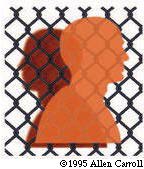 The University of Chicago Magazine
Feb 1995
The University of Chicago Magazine
Feb 1995
By David H. Hoffman I have a neighbor named Johnny. Johnny lives two blocks from the Law School, where I am a third-year student. Despite our proximity, it was highly improbable that Johnny and I would meet, much less become friends. Too many barriers separated us, including a tall fence.
The Law School sits on 60th Street, on the "other side" of the Midway. Behind the school lie its two parking lots and a grassy recreational area. At the end of this space is the fence, ten feet high, topped by barbed-wire struts that no longer hold any barbed wire. The fence successfully separates the school from 61st Street, where Woodlawn begins. A fairly typical "inner-city" neighborhood, Woodlawn is not the worst neighborhood in Chicago, but city statistics generally include it among the worst ten in terms of income, crime, educational achievement, disease, and vacant housing.
This physical barrier between the Law School and Woodlawn is not an anomaly. Much of the University's contemporary history is about building barriers. In the 1950s, the University decided it had two options: leave Hyde Park or insulate itself from the encroaching violence and poverty. It chose the latter. Fences, cul-de-sacs, and one-way streets were used to keep the ivory tower secure. The Law School fence has a clear message for students: For your own safety, don't leave. To the people of Woodlawn, the message is even clearer: Stay out.
The time seemed right to reach out to the people of Woodlawn as neighbors, to move beyond the barriers erected in a time of entrenchment, to resist the dividing lines that crisscross so many of our nation's cities. And so I gathered together a group of friends to launch a volunteer community- service program that would establish links between the Law School and the Woodlawn community. We called it "Neighbors."
We all agreed that deciding how to reach out was just as important as deciding whether to reach out. Reaching out entails risk. By proposing a new relationship, we were asking the people of Woodlawn to trust us. Yet, they saw us as part of a community that in the past had shunned them, looked down on them, and rarely entered into long-term commitments with them. We explained how we would be different; we understood that they knew the problems and their solutions best. We simply wanted to know if we could lend them a hand. We also emphasized that our commitment would not be frivolous. Our goal was not to send a handful of students to a soup kitchen once a month but to build real relationships. Students would be required to volunteer two hours a week in the same program. No excuses.
To our delight, they accepted our proposal and prepared to accept Law School students into their many fantastic programs: a day-care center for senior citizens with Alzheimer's whose families cannot afford nursing homes; an education and counseling program for young mothers, ages 12 to 20; an all-male drug rehabilitation center where we were asked to teach remedial reading; a hospital for abused children needing individual attention.
The Woodlawn leaders also created after-school tutoring programs at the neighborhood's two K-8 schools for us. This is the program I volunteered for, and this is how I met Johnny. A seventh grader, he has grown five inches since we started working together in the fall of '93. At a school where the average sixth grader tests at the third-grade level in reading and math, Johnny's report card regularly carries D's and F's (though not exclusively, he proudly points out to me). When we meet each Monday and Tuesday, his enthusiasm and intelligence are palpable, if unfocused. We work on his math problems and his book reports. I have introduced him to time zones and Langston Hughes. We joke about his girlfriends, and we play basketball. His teachers tell me his scores have improved.
I, too, am improved. I pass through the chain-link fence and enter the world of my Woodlawn neighbors. Over 100 Law School students are part of Neighbors now and join me in this journey every week. They have built relationships with young men at the drug rehab center who want to pass the GED and people with Alzheimer's who just want to chat. Our journey takes us outside the insulated legal world we live in and gives us new insights into the law, new perspectives on the Law School, and new knowledge about ourselves.
Most importantly, though, it gives us new friendships. Last May, the Woodlawn community suggested a joint Law School-Woodlawn party to celebrate the first year of Neighbors. At the YWCA over cake and punch, we mingled together. Volunteers and their Woodlawn friends exchanged hugs and laughs. University administrators talked with Woodlawn social-service leaders. A sixth grader sang, "It's So Hard to Say Good-bye"; another read a poem. Speeches were given and thank yous exchanged. And then we cleaned up and went our separate ways, half of us north, half south.
And as we returned to our school's fenced-in area, the fence no longer meant so much. The barriers that had kept us apart no longer seemed so high. We had created a new community-people with common interests, relationships, memories. Both sides of the fence could now look to the other side and smile warmly. And I had a new friend, my neighbor named Johnny.
David Hoffman grew up in the Chicago area. Next year, he'll clerk for a federal appellate judge in New York City.